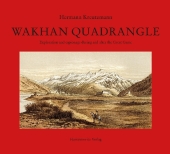 Neuerscheinungen 2017Stand: 2020-02-01 |
Schnellsuche
ISBN/Stichwort/Autor
|
Herderstraße 10
10625 Berlin
Tel.: 030 315 714 16
Fax 030 315 714 14
info@buchspektrum.de |

Hermann Kreutzmann
Wakhan Quadrangle
Exploration and espionage during and after the Great Game
2017. 282 S. 81 ill., 58 maps, 138 photographs. 24 x 26.5 cm
Verlag/Jahr: HARRASSOWITZ 2017
ISBN: 3-447-10812-6 (3447108126)
Neue ISBN: 978-3-447-10812-6 (9783447108126)
Preis und Lieferzeit: Bitte klicken
The Wakhan Quadrangle became an arena of colonial competition when four powers - Afghanistan, China, Great Britain and Russia - struggled for dominance in a remote mountain region where only scattered communities lived in a challenging environment - called the "Great Game".
Prior to this, various international travellers had been sent out, commissioned to record routes, military details and strategic information for the respective parties in the contest. Among the explorers were so-called indigenous intermediaries who were trained in measuring geodetic parameters and who noted down their observations about the customs, culture and economy of the people. They were expected to be knowledgeable in terms of linguistic skills and cultural practices and were less likely than their colonial masters to arouse suspicion.
Munshi Abdul Rahim was an explorer who was sent to Wakhan and Badakhshan in 1879-1880 by the first British Political Agent in Gilgit. His report, reprinted in facsimile, is the centerpiece of this book. It was written during a crucial period for Wakhan that resulted in the imperial division of the formerly independent principality into two parts and the flight and migration of a large share of its inhabitants. His account is preceded by an introduction to the "Great Game" and its implications for the Central Asian interface. Munshi Abdul Rahim´s narrative serves to discuss the function of providers of ´political´ and ´non-political´ information, i.e. the distinction between exploration and espionage from colonial times to the present day.
The comments and interpretations are embedded in archival research and fieldwork done by the author over 40 years.


